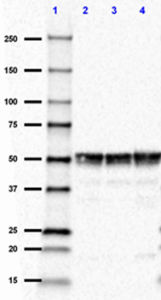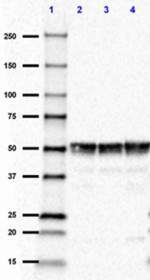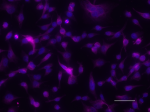- Clone
- 7B9 (See other available formats)
- Regulatory Status
- RUO
- Other Names
- Tubulin beta-2B chain, class IIb beta-tubulin, class II beta-tubulin isotype, tubulin, beta polypeptide paralog
- Previously
-
Covance Catalog# MMS-422P
- Isotype
- Mouse IgG3
- Ave. Rating
- Submit a Review
- Product Citations
- publications

-

Western blot of purified anti-Tubulin-β 2B (TUBB2B) antibody (clone 7B9). Lane 1: Molecular weight marker; Lane 2: 20 µg of human brain lysate; Lane 3: 20 µg of mouse brain lysate; Lane 4: 20 µg of rat brain lysate. The blot was incubated with 1 µg/mL of the primary antibody overnight at 4°C, followed by incubation with HRP labeled goat anti-mouse IgG (Cat. No. 405306). Enhanced chemiluminescence was used as the detection system. -

ICC staining of purified anti-Tubulin-β 2B (TUBB2B) antibody (clone 7B9) on HeLa cells. The cells were fixed with 4% PFA, permeabilized with a buffer containing 0.1% Triton X-100 and 0.25% BSA, and blocked with 2% normal goat serum and 0.02% BSA. The cells were then incubated with 5 µg/ml of the primary antibody for overnight at 4°C, followed by incubation with 5 µg/ml of Alexa Fluor® 647 goat anti-mouse IgG for one hour at room temperature. Nuclei were counterstained with DAPI, and the slides were mounted with ProLong™ Gold Antifade Mountant. The image was captured with a 40X objective. Scale bar: 50 µm -
Xenopus embryos were immunostained with anti-Tubulin-β 2B (TUBB2B) antibody (1:50 dilution, BioLegend Cat. No. 909101), followed by Alexa Fluor® 488 goat anti-mouse IgG (Cat. No. 405319). Immunostained embryos were cleared in BBBA (2:1 benzyl benzoate/benzyl alcohol) and fixed for confocal imaging. Data provided by Dr. Daniel Levy and Richik Mukherjee at the University of Wyoming.
| Cat # | Size | Price | Quantity Check Availability | Save | ||
|---|---|---|---|---|---|---|
| 909101 | 200 µL | 282€ | ||||
Tubulin is a major component of microtubules. It exists as a heterodimer consiting of an alpha and a beta subunit. Class II beta tubulin is the major form of tubulin beta in neurons, although it is not neuronal specific and is found in many other tissues including lung tissue and Schwann cells.
Product DetailsProduct Details
- Verified Reactivity
- Human, Mouse, Rat, Frog
- Antibody Type
- Monoclonal
- Host Species
- Mouse
- Immunogen
- This antibody was raised against the synthetic peptide CEEEEGEDEA found at the c-terminus of beta II tubulin.
- Formulation
- Phosphate-buffered solution + 0.03% Thimerosal.
- Preparation
- The antibody was purified by affinity chromatography.
- Concentration
- 1 mg/ml
- Storage & Handling
- The antibody solution should be stored undiluted between 2°C and 8°C. Please note the storage condition for this antibody has been changed from -20°C to between 2°C and 8°C. You can also check your vial or your CoA to find the most accurate storage condition for this antibody.
- Application
-
WB - Quality tested
ICC - Verified - Recommended Usage
-
Each lot of this antibody is quality control tested by Western blotting. For Western blotting, the suggested use of this reagent is 0.4 - 1.0 µg per ml. For immunocytochemistry, a concentration range of 5.0 - 10 μg/ml is recommended. It is recommended that the reagent be titrated for optimal performance for each application.
- Application Notes
-
This antibody is effective in immunoblotting (WB) and immunocytochemistry (ICC).
Xenopus reactivity was verified by Dr. Daniel Levy’s lab at the University of Wyoming
-
Application References
(PubMed link indicates BioLegend citation) -
- Moody SA, et al. 1996. J. Comp. Neuro. 364: 219.
- Dozier JH, et al. 2003. Breast Cancer Res. 5:R157.
- Product Citations
-
- RRID
-
AB_2565093 (BioLegend Cat. No. 909101)
Antigen Details
- Structure
- Expected MW: 50 kD
- Biology Area
- Cell Biology, Cell Motility/Cytoskeleton/Structure, Neuroscience, Neuroscience Cell Markers
- Molecular Family
- Microtubules
- Gene ID
- 347733 View all products for this Gene ID
- UniProt
- View information about Tubulin-beta 2B on UniProt.org
Related Pages & Pathways
Pages
Other Formats
View All Tubulin-β 2B (TUBB2B) Reagents Request Custom Conjugation| Description | Clone | Applications |
|---|---|---|
| Purified anti-Tubulin-β 2B (TUBB2B) | 7B9 | WB,ICC |
Compare Data Across All Formats
This data display is provided for general comparisons between formats.
Your actual data may vary due to variations in samples, target cells, instruments and their settings, staining conditions, and other factors.
If you need assistance with selecting the best format contact our expert technical support team.

 Login / Register
Login / Register 











Follow Us